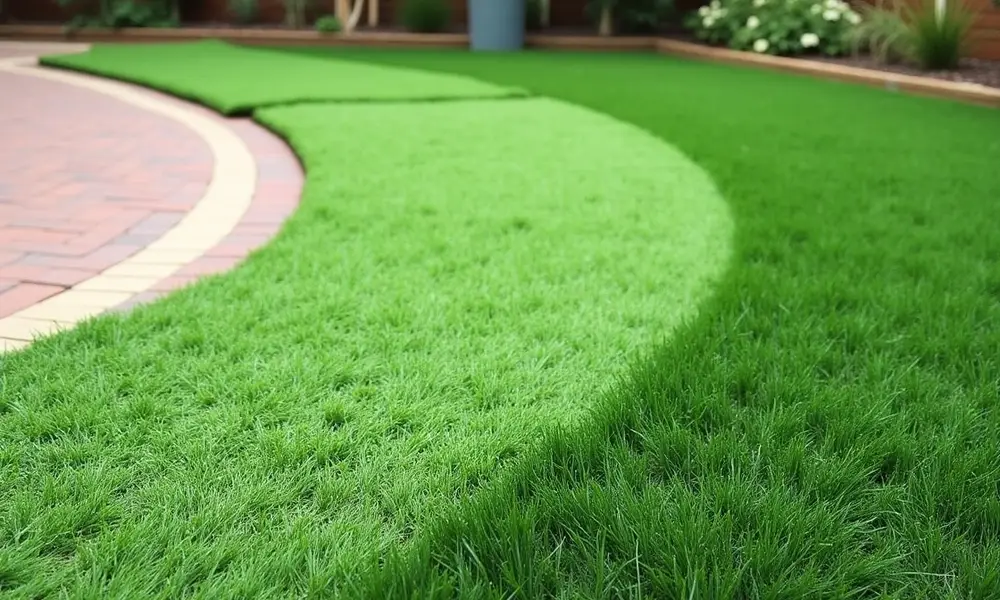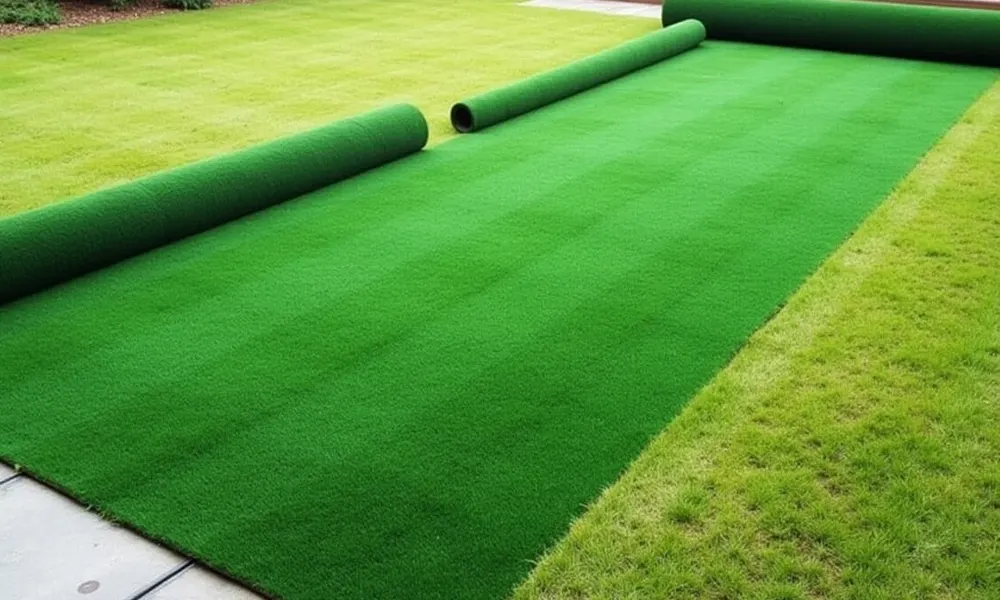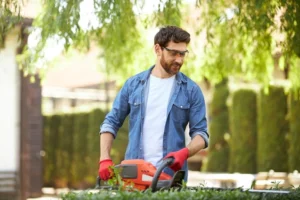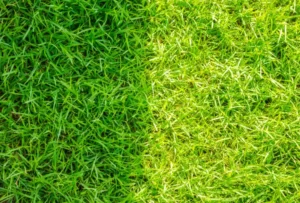Can you lay turf over existing grass and still achieve a healthy, long-lasting lawn? It’s a question many homeowners ask when considering quicker alternatives for lawn improvement. While laying turf over old lawn or installing turf on grass may seem like a convenient shortcut, it often leads to issues like poor root growth, uneven surfaces, and water drainage problems. This method is tempting because it avoids the labor of removing the old grass but the results are rarely as lush or durable as expected. In this guide, we’ll walk you through the key pros, cons, and expert tips to help you make the right choice for your landscape.
Can You Lay Turf Over Existing Grass?

Technically, yes but turfing over existing lawn is generally not recommended if you’re aiming for a healthy, long-lasting result.
What Happens When You Turf Over an Existing Lawn?
At first glance, laying turf over existing grass might seem like an easy time-saver, but it often leads to disappointing outcomes. Here’s why:
- Uneven Decomposition: The old grass underneath breaks down at varying rates, causing bumps and an uneven lawn surface.
- Poor Root Establishment: The new turf has difficulty penetrating the underlying layer, making it harder to access essential nutrients and moisture.
- Increased Risk of Rot and Disease: The trapped grass layer can create a damp, low-oxygen environment ideal for fungal growth and root rot.
What’s Ahead
To help you make an informed choice, we’ll explore:
- Why some homeowners choose turfing over existing lawn
- How to properly prepare the area before laying new turf
- Proven methods to ensure your lawn thrives for years to come
- Why some homeowners choose turfing over existing lawn
What to Consider When Laying New Turf Over Old Grass
Before turfing over existing lawn, it’s important to assess the condition of the area you’re covering. While it might seem like an easy fix, there are several crucial factors to consider. Ignoring these can lead to turf failure and wasted effort.
1. Soil Quality
The success of your new turf on grass depends heavily on what’s underneath. If the existing lawn has poor soil lacking nutrients, structure, or organic matter – the new turf will struggle to establish healthy roots. Ideally, you should remove the old lawn and prepare the soil properly to give the turf the best possible start.
2. Drainage
Poor drainage is one of the biggest killers of new turf. When you lay turf on grass, water can get trapped between the two layers, especially if the underlying soil is compacted or clay-heavy. This stagnant moisture can cause root rot, mold, and other fungal diseases. Always assess how well water moves through the area before turfing.
3. Surface Levelness
An uneven lawn will only become more uneven if you lay turf over existing lawn. The old grass may decompose unevenly, creating lumps, dips, and soft spots in your new lawn. These imperfections are not only unsightly but can also make mowing difficult and promote water pooling in low areas.
4. Weed and Pest Control
If your old lawn had issues with weeds, grubs, or other pests, those problems won’t magically disappear. In fact, laying turf on grass without treating these issues can trap pests below the surface, where they can continue to damage your new turf from underneath.
5. Soil Compaction
Compacted soil is one of the main reasons why turfing over existing lawn fails. New turf roots need to penetrate into the ground to anchor themselves and access water and nutrients. If the old lawn is hard and compacted, roots will struggle to grow, leading to poor establishment and eventual turf dieback.
You can read about Turf installation in Bay area.
6 Reasons Not to Lay New Turf on Top of an Old Lawn
While laying turf over existing lawn might seem like a quick and easy solution, it often leads to disappointing results. Below are six important reasons why this approach is not recommended:
1. Poor Root Establishment
New turf needs direct contact with well-prepared soil to root deeply and securely. When turfing over existing lawn, the old grass layer acts as a barrier, preventing proper root penetration. As a result, the new turf can remain shallow-rooted and unstable.
2. Risk of Turf Disease and Fungus
Old, decaying grass beneath fresh turf creates a damp, oxygen-poor layer that encourages fungal growth and turf diseases. This trapped moisture environment is one of the biggest risks of laying turf over existing lawn.
3. Unwanted Weed Growth from Old Lawn
Any weeds or weed seeds present in the original lawn can easily push through the new turf. Since turfing over existing lawn doesn’t eliminate the problem at the root, you’ll likely see unwanted plants reappear quickly.
4. Uneven Settling and Surface Lumps
As the old lawn breaks down, it decomposes at inconsistent rates, leading to sinking, soft patches, and lumps. This results in a bumpy surface that not only looks unattractive but can also make mowing and walking difficult.
5. Ineffective Nutrient Absorption
Fresh turf requires nutrients from the soil below. If you place turf over existing lawn, the layer of old grass can block nutrient exchange, starving the new turf of essential elements needed for healthy growth.
6. Increased Waterlogging Risk
The leftover grass layer can retain excess water, leading to soggy soil conditions. This significantly raises the chance of waterlogging, especially in areas with poor drainage – a major threat to new turf health.
Why Won’t New Turf Survive Over Old Grass?

Laying new turf over old grass may seem convenient, but it often leads to failure. Here’s why your fresh lawn won’t thrive if it’s simply rolled out over the old one:
A Barrier Between Turf and Soil
When new turf is placed on top of an existing lawn, the layer of dead or dying grass beneath acts as a barrier. Instead of rooting directly into nutrient-rich soil, the fresh turf sits on top of organic matter that is already decomposing. This prevents strong root establishment and makes the turf more vulnerable to environmental stress.
No Direct Contact with Soil
Successful turf installation depends on immediate and firm contact with the soil below. Without that contact, the roots of the new turf can’t integrate into the soil, making it difficult for the grass to anchor itself or absorb essential nutrients and water.
Poor Moisture and Air Circulation
The dead grass layer holds moisture but doesn’t allow proper airflow or drainage. This creates a damp, compact environment that’s ideal for mold, rot, and turf diseases. At the same time, restricted air circulation limits oxygen flow to the developing roots, stunting their growth.
Root Competition Between Layers
Even if the old grass is partially alive or not fully decomposed, it still competes for space, water, and nutrients. This root competition between the old and new layers further weakens the new turf, preventing it from establishing a healthy, independent root system.
If you want service related to landscape design service in Bay area you can contact us.
The Right Way to Lay New Turf
Laying turf correctly is essential for a lush, healthy lawn. Unlike turfing over existing lawn, starting fresh ensures better root growth and long-term success.
Step 1: Remove Existing Grass
Clear out the old lawn using a turf cutter or shovel. For weed-heavy lawns, apply a herbicide and wait before removal. This eliminates pests, weeds, and the barrier that blocks new turf roots.
Step 2: Prepare the Soil
- Till the soil 10–15 cm deep
- Add compost or topsoil if needed
- Level with a rake and lightly firm the surface
- Apply a starter fertilizer to boost root development
Step 3: Lay Turf Properly
- Start along a straight edge and stagger the seams
- Press turf pieces tightly together
- Trim edges as needed and lightly roll the turf
- Water thoroughly right after installation
Final Thoughts
While you can lay turf over existing grass, it’s not the best approach for a healthy, long-lasting lawn. The old grass can cause uneven rooting, moisture issues, and potential pest problems. For optimal results, it’s always best to prepare the soil properly first.
If you have any questions or need professional turf-laying services, don’t hesitate to reach out to us at Lakota Design Group. We’re here to help you achieve the perfect lawn. Contact us today for expert advice and services!
FAQs
What Happens If You Lay Turf Over Old Grass?
When you lay turf over existing lawn, the old grass can create a barrier, preventing the new turf from rooting properly. This can lead to uneven growth, poor moisture circulation, and the risk of pests and diseases.
Why Is It Not Recommended To Turf Over Existing Lawn?
Turfing over existing lawn can result in poor root integration, uneven settling, and limited nutrient absorption. Additionally, it increases the risk of waterlogging and fungal growth, which can harm the new turf.
How Should I Prepare The Lawn Before Laying New Turf?
Before laying turf, remove the old grass, till the soil to a depth of 10-15 cm, level the surface, and apply a layer of compost or fertilizer. This creates an ideal foundation for your new turf to establish strong roots.
Can Turf Roots Penetrate Through Old Grass?
No, turf roots struggle to penetrate the old grass layer. This lack of direct contact with soil can stunt growth and make the turf more vulnerable to diseases and environmental stress.
How Long Should I Wait To Water New Turf After Installation?
Water the new turf immediately after laying it. For the first few weeks, water daily to keep the turf moist until it establishes roots. Adjust watering based on the weather and soil conditions.





